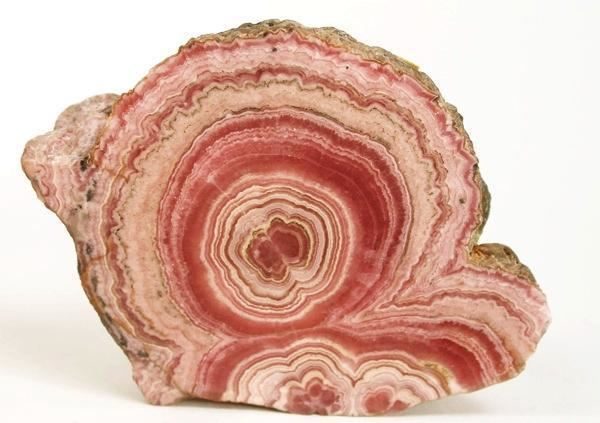Category Carbonate minerals Strunz classification 5.AB.05 Space group R3c | Formula(repeating unit) MnCO3 Crystal system Trigonal | |
 | ||
Crystal class Hexagonal scalenohedral (3m)H-M symbol: (3 2/m) | ||
Rhodochrosite is a manganese carbonate mineral with chemical composition MnCO3. In its (rare) pure form, it is typically a rose-red color, but impure specimens can be shades of pink to pale brown. It streaks white, and its Mohs hardness varies between 3.5 and 4. Its specific gravity is between 3.5 and 3.7. It crystallizes in the trigonal system, and cleaves with rhombohedral carbonate cleavage in three directions. Crystal twinning often is present. It is transparent to translucent with refractive indices of nω=1.814 to 1.816, nε=1.596 to 1.598. It is often confused with the manganese silicate, rhodonite, but is distinctly softer.
Contents
Rhodochrosite forms a complete solid solution series with iron carbonate (siderite). Calcium, (as well as magnesium and zinc, to a limited extent) frequently substitutes for manganese in the structure, leading to lighter shades of red and pink, depending on the degree of substitution. It is for this reason that the most common color encountered is pink.
Occurrence and discovery
Rhodochrosite occurs as a hydrothermal vein mineral along with other manganese minerals in low temperature ore deposits as in the silver mines of Romania where it was first found. Banded rhodochrosite is mined in Capillitas, Argentina.
It was first described in 1813 in reference to a sample from Cavnic, Maramureş, present-day Romania. According to Dimitrescu and Radulescu, 1966 and to Papp, 1997, this mineral was described for the first time in Sacaramb, Romania, not in Cavnic, Romania. The name is derived from the Greek word ῥοδόχρως meaning rose-colored.
Use
Its main use is as an ore of manganese which is a key component of low-cost stainless steel formulations and certain aluminium alloys. Quality banded specimens are often used for decorative stones and jewelry. Due to its being relatively soft, and having perfect cleavage, it is very difficult to cut, and therefore rarely found faceted in jewelry.
Rhodochrosite and silver mining
Manganese carbonate is extremely destructive to the amalgamation process used in the concentration of silver ores, and so until quality mineral specimens became highly sought after by collectors, they were often discarded on the mine dump.
Culture
Rhodochrosite is Argentina's "national gemstone". Colorado officially named rhodochrosite as its state mineral in 2002. Large specimens have been found in the Sweet Home Mine near Alma, Colorado.
It is sometimes called "Rosa del Inca", "Inca Rose" or Rosinca.
